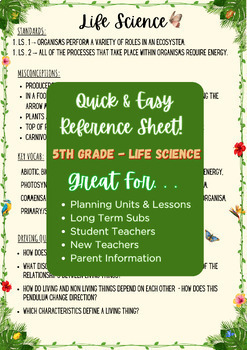Ohio 5th Science - Reference Sheets: Ecosystems, Space, Sound, Light, Motion
VIZSLAMOM
38 Followers
Grade Levels
4th - 12th
Subjects
Resource Type
Standards
CCSS5.G.A.1
CCSSCCRA.L.6
NGSS4-PS4-2
NGSS5-PS1-3
NGSS5-ESS1-1
Formats Included
- Zip
VIZSLAMOM
38 Followers
Description
QUICK, EASY SIMPLE! This reference sheet is for any teacher - new or experience - who needs a reference sheet to help guide lesson planning and data driven decision making!
Ohio 5th Grade Science :: This includes a reference guide for::
-ECOSYSTEMS
-FORCE & MOTION
-SOUND
-LIGHT
-SPACE
Each sheet includes:
-Standards
-Key Vocab
-Common Student Misconceptions
-Driving Questions
Perfect for planning, long term subs, new teachers, and reminders for experienced teachers who just need a refresher before beginning a new unit. These can be hung up in the classroom for target references or used as a syllabus for students, parents and administration to stay informed throughout the year as the students change topics.
Total Pages
Answer Key
Does not apply
Teaching Duration
N/A
Report this resource to TPT
Reported resources will be reviewed by our team. Report this resource to let us know if this resource violates TPT’s content guidelines.
Standards
to see state-specific standards (only available in the US).
CCSS5.G.A.1
Use a pair of perpendicular number lines, called axes, to define a coordinate system, with the intersection of the lines (the origin) arranged to coincide with the 0 on each line and a given point in the plane located by using an ordered pair of numbers, called its coordinates. Understand that the first number indicates how far to travel from the origin in the direction of one axis, and the second number indicates how far to travel in the direction of the second axis, with the convention that the names of the two axes and the coordinates correspond (e.g., 𝘹-axis and 𝘹-coordinate, 𝘺-axis and 𝘺-coordinate).
CCSSCCRA.L.6
Acquire and use accurately a range of general academic and domain-specific words and phrases sufficient for reading, writing, speaking, and listening at the college and career readiness level; demonstrate independence in gathering vocabulary knowledge when encountering an unknown term important to comprehension or expression.
NGSS4-PS4-2
Develop a model to describe that light reflecting from objects and entering the eye allows objects to be seen. Assessment does not include knowledge of specific colors reflected and seen, the cellular mechanisms of vision, or how the retina works.
NGSS5-PS1-3
Make observations and measurements to identify materials based on their properties. Examples of materials to be identified could include baking soda and other powders, metals, minerals, and liquids. Examples of properties could include color, hardness, reflectivity, electrical conductivity, thermal conductivity, response to magnetic forces, and solubility; density is not intended as an identifiable property. Assessment does not include density or distinguishing mass and weight.
NGSS5-ESS1-1
Support an argument that differences in the apparent brightness of the sun compared to other stars is due to their relative distances from Earth. Assessment is limited to relative distances, not sizes, of stars. Assessment does not include other factors that affect apparent brightness (such as stellar masses, age, stage).





